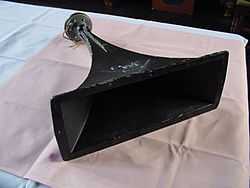Compression driver


A compression driver is a small specialized diaphragm loudspeaker which generates the sound in a horn loudspeaker. It is attached to an acoustic horn, a widening duct which serves to radiate the sound efficiently into the air. It works in a "compression" mode; the area of the loudspeaker diaphragm is significantly larger than the throat aperture of the horn so that it provides high sound pressures. Horn-loaded compression drivers can achieve very high efficiencies, around 10 times the efficiency of direct-radiating cone loudspeakers. They are used as midrange and tweeter drivers in high power sound reinforcement loudspeakers, and in reflex or folded-horn loudspeakers in megaphones and public address systems.
History
In 1924 Hanna, C. R. and Slepian, J. [1] were the first to discuss the benefits of using a large radiating diaphragm with a horn of smaller throat area as a means of increasing the efficiency of horn loudspeaker drivers. They correctly surmised that this arrangement results in a significant increase in the radiation resistance (and therefore increased efficiency), because the loading mismatch between the vibrating transducer surface and air is largely corrected, thus allowing for much better energy transfer. In the Hanna and Slepian proposal the compression cavity is directly connected to the throat of the horn.
The next innovation came from E.C. Wente and A.L Thuras in "A High-Efficiency Receiver for a Horn-Type Loudspeaker of Large Power capacity" in the Bell System Technical Journal, 1928. [2] They devised a plug placed in front of a radiating diaphragm to control the transition from compression cavity to horn throat. They found that the bandwidth of the transducer could be extended to higher frequencies using their phase plug. They also outlined criterion for the design of the channels in the plug and suggested a path-length based design approach to maximize the bandwidth. Significantly, their plug moves the coupling point between the cavity and horn away from the axis of rotation. This change significantly improves the transducer response as the effect of the acoustical resonances in compression cavity is reduced. The paper described the first generation compression driver with a field coil magnet and phase plug, It used aluminum diaphragm with an edge wound aluminum ribbon voice coil.[3]
The first commercial compression driver was introduced 1933 when Bell Labs added a Western Electric No. 555 compression driver as a mid-range driver to their the two-way "divided range" loudspeaker which was developed in 1931.[4]
In 1953 Bob Smith made the most significant contribution to modern phase-plug, and hence compression driver design, with his paper published in the Journal of the Acoustical Society of America [5] in which Smith analyzed the acoustical resonances occurring in the compression cavity and devised a design methodology to suppress the resonances by careful positioning and sizing of channels in the phase-plug. This work was largely ignored by his contemporaries and was only later popularized by Fancher Murray .[6] Today the majority of compression drivers, either by inheritance or design, are based on the guidelines outlined by Smith.
The suppression technique of Smith has been recently extended [7] using a more accurate analytical acoustical model of the compression driver geometry. From this work improved phase plug design guidelines have been deduced to completely eliminate all traces of acoustical resonance in the compression cavity. Interestingly, in this work Smiths derivation is confirmed using Finite Element Analysis, a luxury that was unavailable to Smith.
Compression driver protection
In some sound reinforcement and studio monitors the high frequency drivers are protected by current sensing self-resetting circuit breakers. When too much power is dissipated by the driver, the circuit breaker interrupts the flow of electric current. The circuit breaker resets itself after a brief interval. An older circuit protection technique used by Electro-Voice, Community, UREI, Cerwin Vega and others is a light bulb placed in series with the driver to act as a variable resistor. The resistance of the bulb filament is proportional to its temperature which increases as current flow through the filament increases. The net effect is that the filament consumes an increasing share of the total power thus limiting the power available to the compression driver.[8][9]
References
- ↑ Hanna, C. R.; Slepian, J. (September 1977 (originally published 1924)). "The Function and Design of Horns for Loudspeakers (Reprint)". The Journal of the Audio Engineering Society 25: 573–585.
- ↑ Wente, E.; Thuras, A. (March 1978 (originally published 1928)). "A High-Efficiency Receiver for a Horn-Type Loudspeaker of Large Power Capacity (reprint)". The Journal of the Audio Engineering Society 26: 139–144.
- ↑ http://invalid.ed.ntnu.no/~dunker/refs02.html MORE REFERENCES ON HORN LOUDSPEAKERS
- ↑ http://amplioaudio.blogspot.com/2007/05/short-history-of-audiovideo-technology.html The Short History of Audio/Video Technology
- ↑ Smith, B. (March 1953). "An Investigation Of The Air Chamber Of Horn Type Loudspeakers". The Journal of the Acoustical Society of America 25 (2): 305–312. doi:10.1121/1.1907038.
- ↑ Murray, Fancher (October 1978). "An Application Of Bob Smith's Phasing Plug". Presented at the 61st convention of the Audio Engineering Society. preprint 1384.
- ↑ Dodd, M.; Oclee-Brown, J. (October 2007). "A New Methodology for the Acoustic Design of Compression Driver Phase-Plugs with Concentric Annular Channels". Presented at the 123rd Convention of the Audio Engineering Society. preprint 7258.
- ↑ http://www.audioxpress.com/magsdirx/voxcoil/addenda/media/seaandland.pdf Sea & Land's Speaker Protection Devices
- ↑ http://www.patentstorm.us/patents/6201680/description.html US Patent 6201680 - Adjustable high-speed audio transducer protection circuit